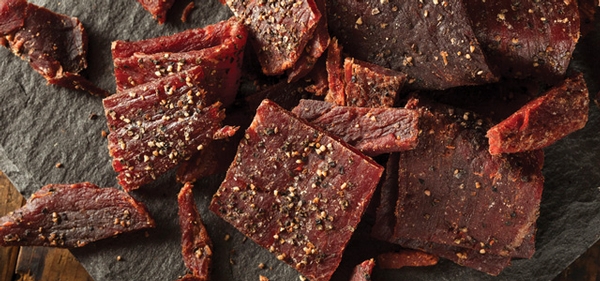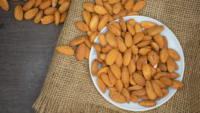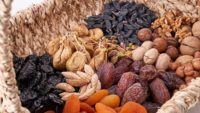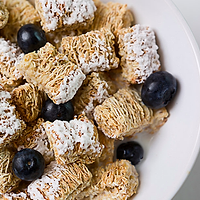Take a slow, relaxing stroll through the aisles of your favorite grocery store and admire the wide spread of fresh produce available for your picking. We often don’t realize it, but the modern shopper is blessed with myriad fresh food options. Advancements in harvesting, storage, transportation and preservation technologies have made it possible for consumers to purchase farm-fresh foods from a cramped sundry store in the middle of a bustling metropolis any time of the year. Therefore, it is perhaps surprising that despite the growing demand for fresh, crisp and raw food options, a sizable amount of drier food products still occupy the shelves.
These low-moisture (LM) foods have survived the test of time (and taste) since the days when dried foods such as jerky and beans were the main sustenance, especially during the winter solstice. These foods do not necessarily have to be bone-dry. For example, dried fruits such as prunes and dates still feel moist, even though they are categorized as LM foods. There are different definitions as to what exactly is considered a “low-moisture food,” but a popular definition by the Food and Agriculture Organization (FAO) of the United Nations states that LM foods are foods with a water activity equal to or less than 0.85.[1] It is imperative to recognize the difference between water activity and moisture content: The former describes the availability of water in the food matrix for chemical reactions and microorganisms, whereas the latter simply refers to the total amount of water in the food product. To illustrate the difference, one could imagine water sealed within an impermeable metal sphere; the moisture content is 100 percent (high moisture content), but that water is certainly “unavailable” (low water activity) to a particularly thirsty individual, unless he/she resorts to violent means. The persistence of LM foods in our food chain indicates that they are still appreciated for their taste, stability and, perhaps more controversially, their safety.
The Safety of LM Foods
As mentioned earlier, LM foods have low water activity, which makes it harder for microorganisms to utilize water in the food matrix. Therefore, the growth of certain pathogenic microorganisms is inhibited. However, a series of foodborne illness outbreaks in LM foods over the past few years has been hacking at the reputation of LM foods as safe. The U.S. Centers for Disease Control and Prevention website lists LM foods implicated in Salmonella foodborne illness outbreaks such as dried nuts, nut spreads, seed powder, cheese and spices.[2] The missing link here is the survivability of these microorganisms: Their growth may be inhibited, but they can still survive. These resilient microorganisms wouldn’t cause an issue if consumers cooked their food, but most LM foods such as dried nuts and peanut butter are consumed without additional preparation. This is certainly understandable from a consumer perspective; LM foods have always been known to be ready to eat. This convenience is perhaps the main selling point for LM foods. Therefore, the straightforward way to tackle this issue is to pasteurize LM foods before they are sold to consumers.
Although the pathway is clear, the means are not. Pasteurizing LM foods is tricky, because their main advantage turns out to be their Achilles heel. LM foods’ dryness does not permit use of hot water or steam, which would otherwise add moisture. These heating media are preferable in the food industry due to their large heat capacity and because water is food-safe. There is an option to use superheated steam that does not condense on food products when controlled properly, but this method is limited to granular food products such as nuts and spices. Alternatively, other gases such as ethylene oxide, chlorine dioxide, ozone or radicals produced from cold plasma could be used, but it is difficult to ensure good penetration into pastes, oily butters and tightly packed granular LM foods. Additionally, some gases could leave residues in the food. The issue of penetration is also encountered in other surface inactivation methods such as infrared, pulsed light and ultraviolet irradiation. Gamma irradiation can pasteurize any form of LM food, because its ionizing radiation can penetrate the food to modify the molecules within bacteria and thus inactivate them. But it can also alter the food molecules to produce undesirable odors or flavors. Additionally, consumers are usually opposed to the use of gamma irradiation in their food products. An alternative to gamma irradiation is microwave heating, which uses nonionizing radiation. The reputation of microwave heating as a fast and easy heating method, however, is tarnished by its tendency toward nonuniform heating. Radio-frequency (RF) heating is a close cousin to microwave heating in the sense that it also uses nonionizing radiation to heat food products. The added advantage of RF heating is that it tends to heat LM foods more uniformly.
How RF Heating Works
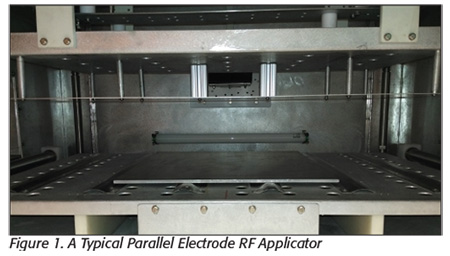 In RF heating, nonionizing electromagnetic radiation is applied to a food product to produce heat within it. Since nonionizing radiation is used, the food molecules are not altered at a molecular level and the main mechanism of inactivation is heat. The typical RF heating setup involves placing the food sample between a pair of parallel electrodes connected to an alternating power supply (Figure 1). RF waves are emitted from the electrodes at frequencies of either 13.56 MHz, 27.12 MHz or 40.68 MHz, as designated by the National Telecommunications and Information Administration.[3] These waves penetrate the food product to create a time-varying electric field that produces heat through two mechanisms: orientation polarization, whereby polar molecules (e.g., water) attempt to orient themselves with the electric field, and ionic conductivity, whereby hydrated ions inside the sample move according to the electric field (Figure 2).[4,5]
In RF heating, nonionizing electromagnetic radiation is applied to a food product to produce heat within it. Since nonionizing radiation is used, the food molecules are not altered at a molecular level and the main mechanism of inactivation is heat. The typical RF heating setup involves placing the food sample between a pair of parallel electrodes connected to an alternating power supply (Figure 1). RF waves are emitted from the electrodes at frequencies of either 13.56 MHz, 27.12 MHz or 40.68 MHz, as designated by the National Telecommunications and Information Administration.[3] These waves penetrate the food product to create a time-varying electric field that produces heat through two mechanisms: orientation polarization, whereby polar molecules (e.g., water) attempt to orient themselves with the electric field, and ionic conductivity, whereby hydrated ions inside the sample move according to the electric field (Figure 2).[4,5]
 The dielectric properties of the food product determine the conversion rate of electromagnetic energy to heat energy. These properties usually depend upon temperature and the oscillation frequency of the electromagnetic waves. The frequencies used in RF heating happen to coincide with the region at which bound water is strongly heated.[6] This is advantageous for heating LM foods due to their higher ratio of bound to free water. Additionally, RF waves tend to penetrate deep into LM foods. Thus, it is possible to design RF heating equipment to deeply penetrate LM foods and heat them uniformly to ensure food safety.
The dielectric properties of the food product determine the conversion rate of electromagnetic energy to heat energy. These properties usually depend upon temperature and the oscillation frequency of the electromagnetic waves. The frequencies used in RF heating happen to coincide with the region at which bound water is strongly heated.[6] This is advantageous for heating LM foods due to their higher ratio of bound to free water. Additionally, RF waves tend to penetrate deep into LM foods. Thus, it is possible to design RF heating equipment to deeply penetrate LM foods and heat them uniformly to ensure food safety.
The application of RF heating in food has a long history that dates back to 1945, when Moyer and Stotz used it to blanch vegetables.[7] In the next seven decades, research in the area slowly increased, with a large resurgence over the past few years. RF heating is researched for various applications in food such as drying, controlled freezing or thawing, insect control, pasteurization or sterilization and extraction. Some of the food products that were tested for pasteurization with RF heating include almonds, bread, cured ham, eggs, milk, meat, peaches, peanut butter, crackers, sausage emulsions, soy milk, spices and stone fruit. Clearly, RF heating has been investigated for a wide selection of food products. More in-depth reviews of RF heating applications can be found in the works of Huang et al.,[8] Marra et al.[9] and Piyasena et al.[10] With the introduction of the Food Safety Modernization Act (FSMA), there is now a bigger drive to devise more applications of RF heating and validate it for the pasteurization of LM foods.
Results Vary by Food Type
The quality of foods processed with RF heating can vary, depending on the food and design of the RF applicator. Bengtsson et al.[11] found that RF-processed hams were juicier and had shorter process times than hams conventionally heated. On the other hand, Laycock et al.[12] concluded that RF heating is unsuitable for ground beef because the end product was too chewy and elastic. When processed with RF heating, meat doughs became more firm and had larger, irregularly shaped fat particles than their hot water-processed counterparts.[13] Liu et al.[14] investigated RF heating for bread and found insignificant firmness changes. After RF heating and storage for 12 days, mangoes were found to be firmer than their control counterparts.[15] The color of red and black peppers pasteurized with RF heating was not significantly different from control samples.[16] Wang et al.[17] reported that the lightness, peroxide value and oleic acid content of walnuts were not significantly degraded by RF heating. The berry of cherries slightly browned after RF heating.[18] RF heating browned the calyx in “Fuyu” persimmons with increasing intensity as treatment time was increased.[19] There was noticeable darkening in the pulp of apples processed with RF heating.[20] Although the quality of food is neither decidedly improved nor degraded by RF heating, it is necessary to evaluate its effect on quality when investigating RF heating for a new application.
Most of the applications listed thus far tended to focus on just a single RF heating configuration for a feasibility study in a controlled setting. However, FSMA requires pasteurization technologies to be validated for effectiveness, even in worst-case scenarios. The natural variation in food products and the sensitivity of RF waves to these variations makes it difficult to design an RF pasteurizing system that heats the food product uniformly. If the product is not heated uniformly, some pathogenic microorganisms could survive at the cold spots and cause food safety issues. There could be an infinite amount of ways to configure the RF oven for different food products, thus making this problem insurmountable by trial and error. However, with the rise of cheap computing power, more studies have been done that model RF heating for food products to understand how it works. The ultimate goal is to optimize heating uniformity. Marra et al.[21] investigated the uneven heating in a cylindrical meat batter and had good agreement with experimental results. Birla et al.[22] utilized computer simulations to understand the temperature distribution in fruits processed with RF heating while immersed in water. Tiwari et al.[23] investigated the power density distribution and heating profile of dry foods such as wheat flour with the help of computer simulations. Wang et al.[24] found a high degree of nonuniform RF heating in lasagna due to its heterogeneous ingredients with large differences in dielectric properties. Based on computer simulations, Alfaifi et al.[25] suggested rounding the corners and edges of food products and modifying the top RF electrode to improve RF heating uniformity in food products. Lau et al.[26] used computer simulations to investigate RF heating of eggs and determined the intense heating at the air cell-albumen interface to be caused by stark differences in dielectric properties. There is research ongoing in this area to design the RF applicator or food product with the help of computer simulations to improve RF heating uniformity of food products.
Conclusions
The large body of active research on RF heating signifies that the technology is still not fully mature and thus has potential for more applications in LM food pasteurization. The ability of RF heating to heat food products volumetrically is a desirable trait that could tackle issues insurmountable by conventional methods. As the ongoing research on RF heating comes closer to fruition, we can look forward to RF heating transitioning from a novel technology to a more common and reliable solution.
Soon Kiat Lau is a Ph.D. student at the University of Nebraska–Lincoln.
Jeyamkondan Subbiah, Ph.D., P.E., is the Kenneth E. Morrison Distinguished Professor of Food Engineering in Biological Systems Engineering and Food Science & Technology at the University of Nebraska–Lincoln.
References
1. FAO, 2015. Code Hygienic Practice for Low-Moisture Foods.
2. www.cdc.gov/salmonella/outbreaks.html.
3. Schroeder, N and M Murray. 2003. United States Frequency Allocations.
4. de Loor, GP. 1968. “Dielectric Properties of Heterogeneous Mixtures Containing Water.” J Microw Power 3:67–73.
5. Nyfors, E and P Vainikainen. Industrial Microwave Sensors (Boston: Artech House, 1989).
6. Awuah, GB et al. Radio-Frequency Heating in Food Processing (Boca Raton, FL: CRC Press, Taylor & Francis Group, 2015).
7. Moyer, JC and E Stotz. 1945. “The Electronic Blanching of Vegetables.” Science 102:68–69.
8. Huang, Z et al. 2017. “Computer Simulation for Improving Radio Frequency (RF) Heating Uniformity of Food Products: A Review.” Crit Rev Food Sci Nutr in press.
9. Marra, F et al. 2009. “Radio Frequency Treatment of Foods: Review of Recent Advances.” J Food Eng 91:497–508.
10. Piyasena, P et al. 2003. “Radio Frequency Heating of Foods: Principles, Applications and Related Properties—A Review.” Crit Rev Food Sci Nutr 43:587–606.
11. Bengtsson, NE et al. 1970. “Radio-Frequency Pasteurization of Cured Hams.” J Food Sci 35:682–687.
12. Laycock, L et al. 2003. “Radio Frequency Cooking of Ground, Comminuted and Muscle Meat Products.” Meat Sci 65:959–965.
13. van Roon, PS et al. 1994. “Mechanical and Microstructural Characteristics of Meat Doughs, either Heated by a Continuous Process in a Radio-Frequency Field or Conventionally in a Waterbath.” Meat Sci 38:103–116.
14. Liu, Y et al. 2013. “Heating Patterns of White Bread Loaf in Combined Radio Frequency and Hot Air Treatment.” J Food Eng 116:472–477.
15. Sosa-Morales, ME et al. 2009. “Dielectric Heating as a Potential Post-Harvest Treatment of Disinfesting Mangoes, Part II: Development Of RF-Based Protocols and Quality Evaluation of Treated Fruits.” Biosyst Eng 103:287–296.
16. Kim, S-Y et al. 2012. “Radio-Frequency Heating to Inactivate Salmonella Typhimurium and Escherichia coli O157:H7 on Black and Red Pepper Spice.” Int J Food Microbiol 153:171–175.
17. Wang, S et al. 2007. “Industrial-Scale Radio Frequency Treatments for Insect Control in Walnuts: II: Insect Mortality and Product Quality.” Postharvest Biol Technol 45:247–253.
18. Monzon, ME et al. 2006. “Effect of Radio Frequency Heating as a Potential Quarantine Treatment on the Quality of ‘Bing’ Sweet Cherry Fruit and Mortality of Codling Moth Larvae.” Postharvest Biol Technol 40:197–203.
19. Tiwari, G et al. 2008. “Effect of Water-Assisted Radio Frequency Heat Treatment on the Quality of ‘Fuyu’ Persimmons.” Biosyst Eng 100:227–234.
20. Wang, S et al. 2006. “Postharvest Treatment to Control Codling Moth in Fresh Apples Using Water Assisted Radio Frequency Heating.” Postharvest Biol Technol 40:89–96.
21. Marra, F et al. 2007. “Radio-Frequency Heating of Foodstuff: Solution and Validation of a Mathematical Model.” J Food Eng 79:998–1006.
22. Birla, SL et al. 2008. “Computer Simulation of Radio Frequency Heating of Model Fruit Immersed in Water.” J Food Eng 84:270–280.
23. Tiwari, G et al. 2011. “Analysis of Radio Frequency (RF) Power Distribution in Dry Food Materials.” J Food Eng 104:548–556.
24. Wang, J et al. 2012. “Radio-Frequency Heating of Heterogeneous Food — Meat Lasagna.” J Food Eng 108:183–193.
25. Alfaifi, B et al. 2016. “Computer Simulation Analyses to Improve Radio Frequency (RF) Heating Uniformity in Dried Fruits for Insect Control.” Innov Food Sci Emerg Technol 37 (Part A):125–137.
26. Lau, SK et al. 2016. “Challenges in Radiofrequency Pasteurization of Shell Eggs: Coagulation Rings.” J Food Sci 81:E2492–E2502.
